The symbolic act of naming of an Orchid in Singapore has been a long-standing local tradition to recognize distinguished individuals, signify an organisation or commemorate significant events. The Aranda Lee Kuan Yew (2016) was named after our former Prime Minister and one of Singapore’s esteemed founding fathers, Mr. Lee Kuan Yew.
The officially registered name of a new Orchid hybrid is unique and recognised internationally.
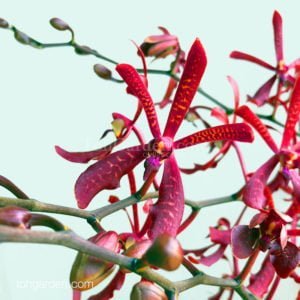
Often, orchid naming is used as a soft diplomatic act, naming blooms after distinguished notable dignitaries such as Former US President Barack and Michelle Obama, Chinese President Xi Jinping or Indian Prime Minister Narendra Modi.
After choosing a new hybrid, it is registered with the Royal Horticultural Society in UK, the world’s singular authority and registry on orchids. Specially created souvenirs of the orchid are sometimes also made for the event.
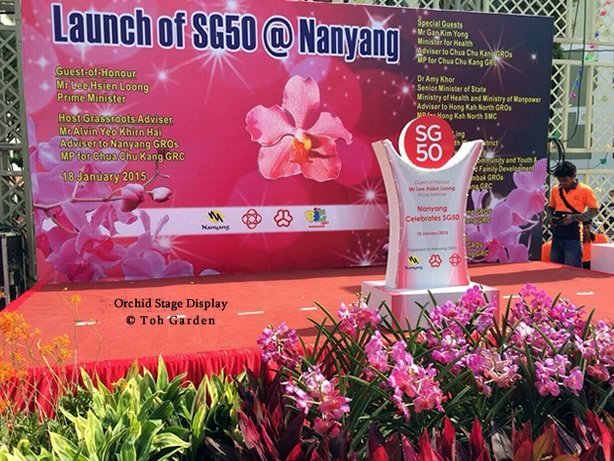
Here at Toh Garden, new hybrids are constantly being created. For corporate / event orchid naming, our expertise can help you in the selection and cultivation of new hybrids, from start to finish.
If you are a hobbyist or educator with orchids at hand and the know-how, creating your own orchid hybrid is a rewarding and enriching experience. It also makes for a great exercise for a biology class on plant reproduction!
So How Are New Orchid Hybrids Made?
“(Hybridisation) is like a box of chocolate. You never know (for sure) what you’re gonna get!” – Forrest Gump.
The process of creating a new orchid hybrid starts with the selection of 2 parent orchid plants with favourable ‘looks’ and ‘genes’. The resulting plant is usually an intermediate of the two parents.
Examples of ideal traits for cut flowers are longer lasting blooms, frequent flowering and a wide range of colours, to name a few. Desired growth habits, disease resistance, are some of the other traits also considered during the selection process. Many hybrids carried by growers today are the result of many decades of selective hybridisation, with growers opting to grow superior offspring hybrids over the parent plants.
The act of pollination by hand is a simple one. Orchids are bisexual, meaning both male and female parts can be found on the same flower. The pollen of one parent plant is transferred onto the stigma, using a simple tool such as a cotton bud or toothbrush. When this is done on the same plant, it is called self-pollination. However, when this is done on a different plant, called cross-pollination, the result is a new orchid hybrid. Entirely new genera are sometimes created this way! This exciting process has a long wait though, as the following diagram illustrates.
The Making of a New Hybrid
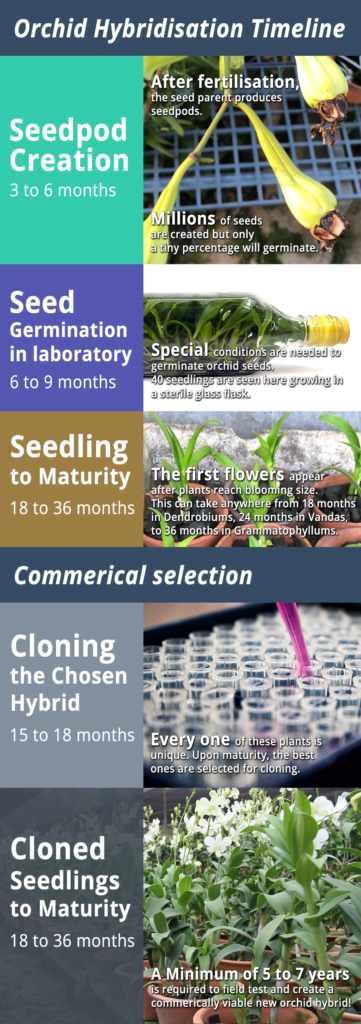
3 years and no flower?! The Challenges of Creating New Hybrids
There is no guarantee, however, that every cross will be successful. There are tripping stones at every step of the process. Genetically unstable crosses can end up with empty seedpods, unviable or sterile offspring plants. Sometimes, plants reach maturity after many years but fail to produce satisfactory flowers. The extensive time, effort and resource spent on this endeavour mean it is also a costly one, with each cycle costing a few thousand dollars. Advice from experienced growers and hybridisers, however, can help reduce failings.
Still, a lot of fun and worth trying
Have your own orchid garden? Try creating your own hybrid today!
If you need a structured growing regime and instructor for schools and corporates, our Orchid Hybridisation and Cultivation Experiential Programme is a great way to initiate valued employees or new students into the world of growing orchids.
Programme outline:
- Start the 1st year with a fun 2hr workshop on orchid growing and hybridisation.
- Mail the seedpods created (after 3 to 6 months) to Temasek Laboratory / National Parks to germinate the seeds in sterile flasks. Alternatively, for schools with labs equipped with a laminar flow cupboard, opt for the Orchid Seed Germination Workshop.
- By the student’s / employee’s 2nd year, seedlings are ready to be deflasked and potted in small pots. If you have more than 200 plants, opt to cultivate seedlings with us for a minimum of 3 months or up to a year until blooming size.
- By the 3rd year, plants that have reached blooming size will begin to flower (or not). If flower, success! Every plant is unique. Name the orchid after the class / employee batch for posterity. Every student can bring back their own pot of orchid for graduation.


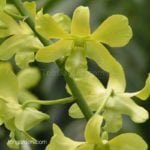
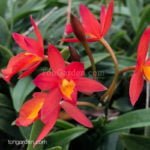

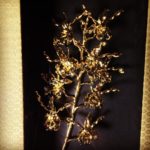


ME SUMIT STAY IN INDIA I WANTS TO LEARN ABOUT ORKIT FLOWRES GRADREN I LIKE FLOWERS IN MY CHILDHOOD IT IS MY HOBI BUT I HABE NO SPOCE TO DEVALOP THIS. SO I REQUEST TO YOU PLS HELP MWABOUT MY DREAM.THANKS
Hello Sumit,
We do provide services to produce new orchid hybrids to be named after yourself.
Do email us for more information.
silverelf
Hi,
Do u have readily available new orchids which we can purchasing for naming after someone?
If so, how much does it cost?
Thanks!
Warmest regards,
Spencer
Hello Spencer,
Yes, we have new hybrids that are in bloom offered for naming.
Will check our farm and drop you an email with the pictures of hybrids currently available soon.
Thank you
silverelf
Please let me know the cost of naming a new hybrid orchid after some one
Thank you
Hi Slyvia,
We will get back to you asap after checking the new hybrids that we have now.
Thank you.
silverelf
Hi,
Could you let me know which are the new hybrid that are ready to buy for naming?
Thanks,
Alvin
Hi Alvin,
Apologies for late reply, we’ve replied you via email.
silverelf
Hello
Do you have any hybrids available for naming?
Hi Marianne,
Please drop an email to [email protected] and we will send you pictures of new hybrids we have now.
Thank you
silverelf
Hello would like a list of hybrids to choose from n to know the price for naming pls. Thank you.
Hi Linda,
We’ve replied you via email.
Thank you.
silverelf
Hi, can you send me a list of orchid hybrids that are available for naming as well as the price range? Many thanks
Hi,
I am interested to find out if your nursery carries out orchid hybridisation workshop for primary students? Thank you.
Hi Ms Teo,
We will drop you an email, thanks!
silverelf